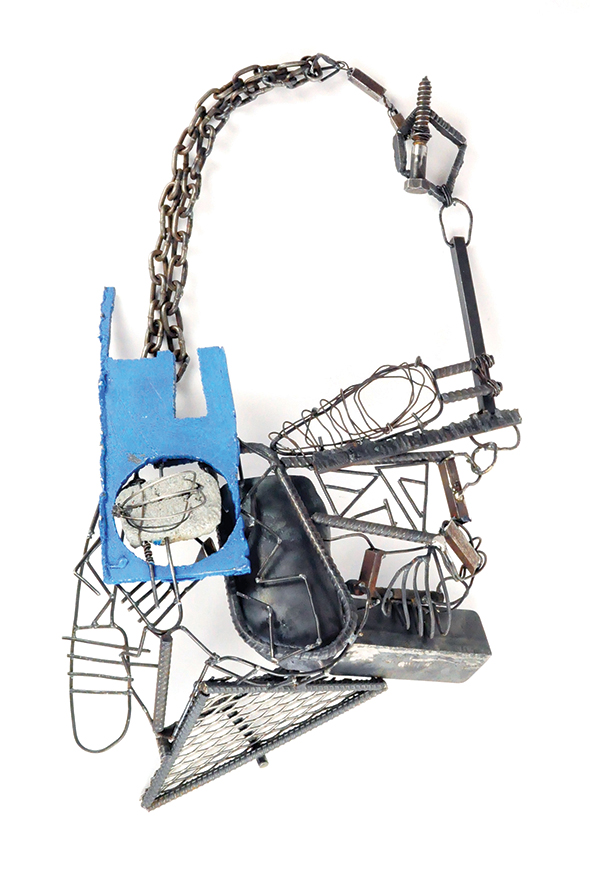The Deconstructed Art of Orly Ruaimi
When you look at the work of San Francisco-based artist Orly Ruaimi, you would never guess that the forty-two-year-old started out in finance. That career path didn’t pan out, and it’s easy to see why: Ruaimi’s jewelry and sculptures seem to effortlessly emerge from the ruins of some futuristic city. Her paintings vibrate with a similar intensity, abstract visions of vibrant textures that overlap and intersect and diffuse. Necklaces of shiny tangled pipes; laser cut earrings that ripple and splatter; a steel mesh handbag sculpture almost too heavy to move. This is Ruaimi’s reality and oeuvre.
With an MFA in Jewelry and Metal Arts from Academy of Art University and a second MFA in Sculpture from San Francisco Art Institute in progress, Ruaimi has discovered her creative niche. Found industrial objects with colorful pops define her aesthetic, and her jewelry and sculpture explore the ethical implications of repurposed materials. Ruaimi has also ventured into the technological realm, collaborating with the Silicon Valley-based company Kovio. She designed Oroglass plastic accessories that incorporated Kovio’s wireless communication tags, which transfer data between two devices when touched or in proximity. After that project ended, she continued to experiment with wearable art pieces that could encase the technology. Her Cyborg collection, the product of those efforts, examines how the digital and material worlds collide and can, ultimately, function together.
Ruaimi’s latest solo show, “Free Yourself Be Fearless,” features five steel sculptures and five two-dimensional wall pieces. It also includes some previous works from past collections, exhibiting Ruaimi’s artistic range. The exhibition opens October 1st at The Cannery Galleries in Suite 108, located in the bustling Fisherman’s Wharf district. Through intricate, deconstructed designs, Ruaimi seeks to expose what lies beneath the surface, and here she shares her insights and processes with SOMA.
Where do you draw inspiration?
Patterns, structures, and raw materials. Foundations of buildings, networks of spider webs, or just a pile of laundry can inspire me.

How do you choose materials for your art?
In a way, the material chooses me. Inspired and overwhelmed by all the construction in San Francisco recently, I couldn’t ignore all the substructures that were creating a new landscape of the city. Steel rebar and concrete is in almost every corner. It inspired me to utilize the qualities of these materials and to create an unexpected form, like a handbag, for example.
What would you say your work is “about”? What message do you try to convey through your art?
My work questions the relationship between the body’s inner and outer image through layering gestures on canvas and welding large-scale sculptural objects. My sculptural collections are intended to challenge the wearer’s perception of beauty, status, and material wealth. Instead of serving to adorn the human figure, these pieces begin to consume the wearer, wrapping them in a sense of security while also confining or trapping them in a hard shell of their exterior facade.
One of your more recent collections of accessories, “RECycled,” explores the act of letting go. How did the idea for this collection come about?
The idea came about from a relationship to a person I had that was causing me frustration. Like any artist, I express my feelings through my work. I was thinking about how to alleviate that frustration, and at about the same time I found the bike chain as a medium. Bike wheels move only because the bike chain connects them, and the medium explores moving forward, letting go, and moving on. The chain as a material allows the viewer to recognize it as the cause of movement, but I placed it in a setting where the movement is only a conceptual suggestion.

How has your process and work evolved over time?
My process is very intuitive. I don’t do a lot of sketching, measuring, or researching—I outline, estimate and experiment. Moving from jewelry making to sculpture was a natural evolution of my work. Even when I was creating jewelry it was never in a “normal” scale, and it was always very sculptural. Jewelry is considered an intimate object since it’s something we carry on us, as opposed to sculpture, which is meant to be appreciated as an independent entity. By exponentially enlarging my work, the object has claimed its existence.
What are your aspirations for the future?
I would like the opportunity to share my concept with people; inspire them to look beyond what is obvious and see the hidden possibility; to unveil or bring into focus all the “social” layering we do in order to “fit in” or become a person we think people want to associate with. Through that, I want to encourage people to be who they genuinely are without any façade—raw.
Text by Noelani Piters
Photograph by Tina Maliga


